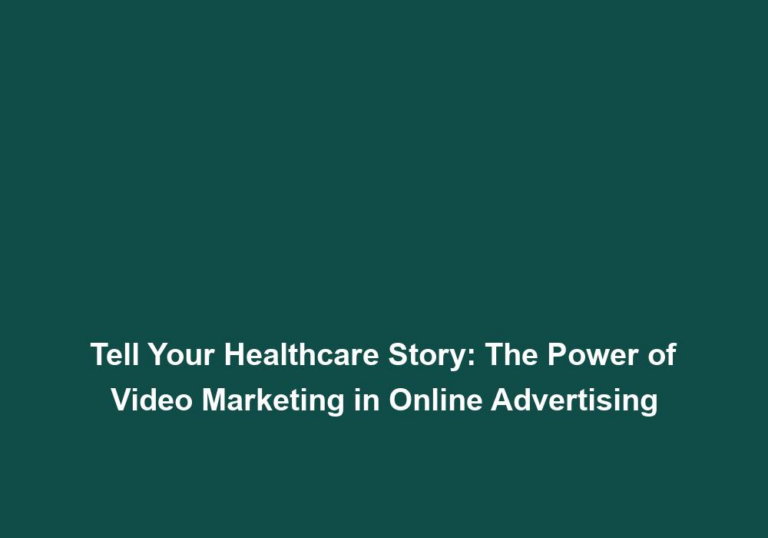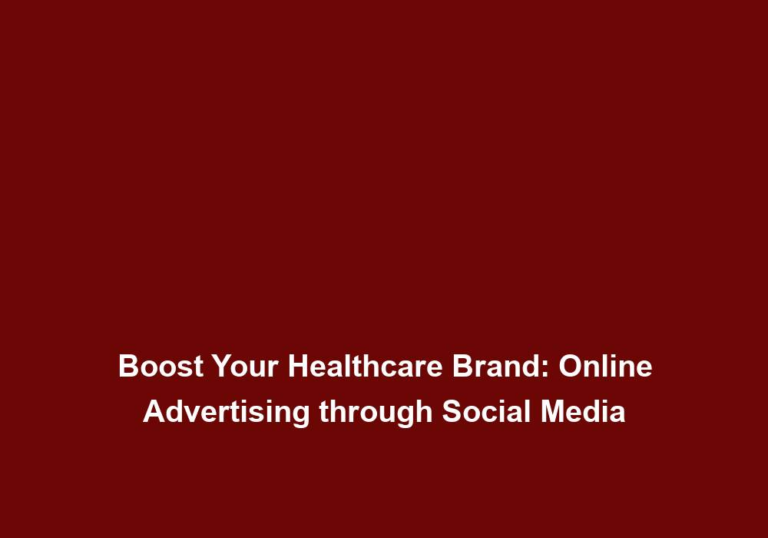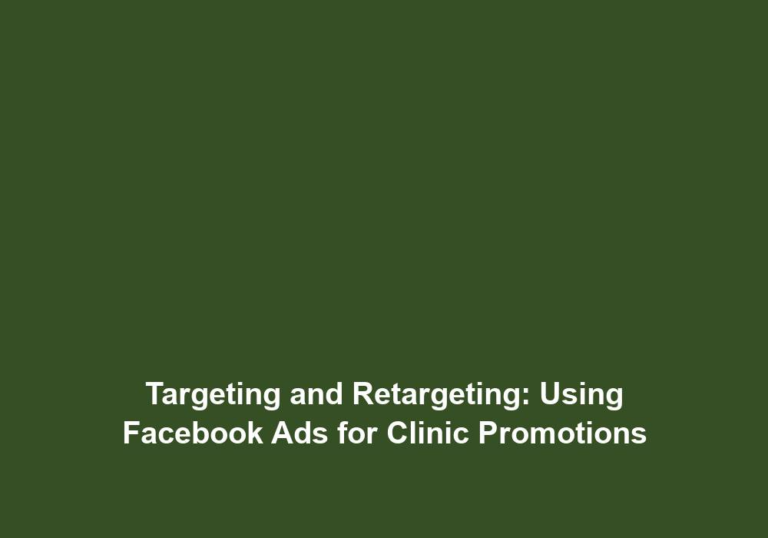Maximizing ROI: Healthcare’s Guide to PPC Campaign Success
In today’s digital age, healthcare organizations must embrace innovative marketing strategies to stay competitive and reach their target audience effectively. One such strategy that has proven to be immensely successful is Pay-Per-Click (PPC) advertising. By utilizing PPC campaigns, healthcare providers can maximize their Return on Investment (ROI) and achieve substantial growth in patient acquisition and revenue generation. In this comprehensive guide, we will explore the key factors that contribute to the success of PPC campaigns in the healthcare industry, providing valuable insights and actionable tips for healthcare professionals looking to optimize their digital advertising efforts.
Understanding the Basics of PPC Campaigns
Before delving into the intricacies of maximizing ROI through PPC campaigns, it is vital to have a solid understanding of the basic concepts. PPC advertising is a digital marketing model where advertisers pay a fee each time their ad is clicked. These ads are shown to users who are actively searching for specific keywords related to the advertiser’s offerings. In the healthcare sector, PPC campaigns can be incredibly effective in reaching potential patients who are actively seeking medical solutions or services.
PPC campaigns operate on an auction-based system, where advertisers bid on keywords that are relevant to their healthcare services. When a user searches for those keywords, the search engine displays the ads of the highest bidders. This means that healthcare organizations have the opportunity to gain significant visibility and reach their target audience at the right moment.
To ensure the success of your PPC campaign, it is crucial to define clear objectives and identify your target audience. By having a clear understanding of your goals, whether it’s increasing patient appointments, promoting a specific service, or boosting brand awareness, you can tailor your campaign accordingly. Additionally, identifying your target audience enables you to create compelling ad copies and select relevant keywords that resonate with potential patients.
Conducting Thorough Keyword Research
One of the fundamental aspects of a successful PPC campaign is thorough keyword research. By identifying the right keywords, you can optimize your ads to appear in front of the most relevant audience. Start by brainstorming a list of keywords that are closely related to your healthcare services. Consider the medical procedures, treatments, or healthcare specialties you offer, and think about the specific terms potential patients might use when searching for those services.
Once you have your initial list of keywords, utilize keyword research tools such as Google Keyword Planner, SEMrush, or Moz to refine your list and identify high-volume, low-competition keywords that align with your objectives. These tools provide valuable insights into search volume, competition level, and suggested bid amounts for each keyword. By selecting the right keywords, you can ensure that your ads are displayed to the most relevant audience, increasing the likelihood of conversions.
Crafting Engaging Ad Copies
Your ad copies play a significant role in attracting potential patients and encouraging them to click on your ads. It is crucial to create compelling, concise, and engaging ad copies that highlight your unique selling points and differentiate you from your competitors. Emphasize the benefits of your services, include strong call-to-action phrases, and ensure your ad copies are aligned with the keywords being targeted. Additionally, consider using ad extensions, such as site links or call extensions, to provide additional information and make your ads more enticing.
When crafting your ad copies, consider the pain points or challenges that potential patients might be experiencing. Address those concerns in your ad copy and position your healthcare organization as the solution they are looking for. Highlight any unique features or advantages that set you apart from other providers. Use specific and descriptive language to convey the value and benefits of choosing your healthcare services.
Optimizing Landing Pages
Once a user clicks on your ad, it is essential to provide them with a seamless and optimized experience on your landing page. Ensure that your landing page is relevant to the ad copy and keywords, and offers valuable information that fulfills the user’s search intent. Optimize the page for fast loading times, mobile responsiveness, and an intuitive user interface. Consider including a prominent call-to-action button that directs users to take the desired action, such as scheduling an appointment or requesting more information.
To maximize the effectiveness of your landing pages, consider implementing the following strategies:
-
Clear and compelling headlines: Use attention-grabbing headlines that clearly communicate the value proposition of your healthcare services. Highlight the benefits and unique features of your offerings to capture the user’s interest.
-
Engaging and informative content: Provide detailed information about your healthcare services, including the benefits, the procedures involved, and any additional resources or support available. Use a combination of text, images, and videos to engage users and provide a comprehensive understanding of your services.
-
User-friendly design and navigation: Ensure that your landing page is visually appealing and easy to navigate. Use a clean layout, clear headings, and intuitive menus to guide users through the page. Make it easy for them to find the information they need and take the desired action.
-
Trust indicators and testimonials: Build trust and credibility by including testimonials from satisfied patients, certifications, awards, or any other relevant credentials. These trust indicators can help alleviate any concerns or doubts potential patients may have and increase the likelihood of conversions.
Implementing Conversion Tracking and Analytics
To measure the success of your PPC campaign and identify areas for improvement, it is crucial to implement conversion tracking and analytics. By setting up conversion tracking, you can track various actions taken by users, such as appointment bookings, form submissions, or phone calls. This data provides valuable insights into the effectiveness of your campaign and allows you to make data-driven decisions to optimize your ROI. Additionally, regularly monitor your campaign’s performance through analytics tools like Google Analytics to identify trends, analyze user behavior, and refine your strategies accordingly.
Conversion tracking allows you to attribute specific actions to your PPC campaigns, providing a clear understanding of the return on investment for each campaign. By tracking conversions, you can identify which keywords, ads, or landing pages are driving the most valuable actions and allocate your budget accordingly. This data-driven approach helps you optimize your campaigns and maximize your ROI.
A/B Testing and Continuous Optimization
An essential aspect of maximizing ROI in PPC campaigns is continuous optimization through A/B testing. Experiment with different ad copies, landing page designs, call-to-action phrases, and keywords to identify the most effective combinations. Split your audience into different segments and test various elements to refine your campaign over time. Analyze the results and make data-driven decisions to optimize your PPC campaign’s performance and maximize your ROI.
Some elements you can test through A/B testing include:
-
Ad copy variations: Test different headlines, descriptions, and call-to-action phrases to determine which combinations generate the highest click-through rates and conversions.
-
Landing page design: Experiment with different layouts, colors, and visuals to see which designs lead to longer page visits and higher conversion rates.
-
Keyword variations: Test different variations of your targeted keywords to identify the ones that generate the most relevant traffic and conversions.
By continuously testing and optimizing your PPC campaigns, you can ensure that your budget is allocated to the most effective strategies, resulting in increased ROI and improved campaign performance.
Leveraging Remarketing Strategies
Remarketing, also known as retargeting, is a powerful technique that allows you to reach users who have previously interacted with your website or ads. By utilizing remarketing strategies, you can stay top-of-mind with potential patients who have shown interest in your healthcare services. Display targeted ads to this audience, providing them with personalized messages and incentives to revisit your website or take the desired action. Remarketing can significantly improve your conversion rates and ROI by capitalizing on warm leads that are already familiar with your brand.
To effectively leverage remarketing strategies, consider the following tactics:
-
Segmentation: Divide your audience into different segments based on their behavior on your website. For example, create a segment for users who have visited specific service pages or added items to their cart but did not complete the purchase. By segmenting your audience, you can deliver personalized ads that address their specific needs or concerns.
-
Dynamic remarketing: Utilize dynamic remarketing to display ads that showcase the specific services or products that users have previously shown interest in. This personalization can greatly increase the chances of conversion by reminding users of the specific healthcare solutions they were considering.
-
Incentives and promotions: Offer exclusive incentives or promotions to users who have previously interacted with your website. This can be in the form of discounts, free consultations, or additional value-added services. By providing these incentives, you can entice users to revisit your website and take the desired action.
-
Frequency capping: Set frequency caps to ensure that your remarketing ads are not overly intrusive or repetitive. This helps maintain a positive user experience while still keeping your brand top-of-mind.
Remarketing allows you to nurture leads that are already familiar with your brand, increasing the likelihood of conversions and maximizing your ROI.
Monitoring and Regular Reporting
Consistent monitoring and reporting of your PPC campaign’s performance are vital to ensure ongoing success. Keep a close eye on key metrics such as click-through rates, conversion rates, cost per acquisition, and return on ad spend. Regularly analyze the data, identify trends, and make informed decisions to optimize your campaign. Generate comprehensive reports that provide insights into the effectiveness of your PPC efforts, highlighting areas of success and opportunities for improvement.
By monitoring your campaign’s performance, you can identify which strategies are working well and which ones need adjustment. This allows you to allocate your budget effectively, optimize your ads and landing pages, and refine your targeting to maximize your ROI. Regular reporting also helps you communicate the results and impact of your PPC campaigns to stakeholders within your healthcare organization, fostering transparency and alignment.
Conclusion
By following this comprehensive guide, healthcare providers can confidently navigate the world of PPC advertising and maximize their ROI. Keep in mind that successful PPC campaigns require a combination of strategic planning, continuous optimization, and data-driven decision-making. By defining clear objectives, understanding your target audience, conducting thorough keyword research, and implementing effective tracking and optimization techniques, you can unlock the full potential of PPC campaigns and achieve significant growth in patient acquisition and revenue generation. Embrace the power of digital marketing and take your healthcare organization to new heights with a well-executed PPC campaign.







